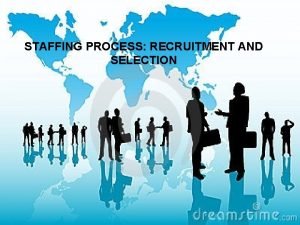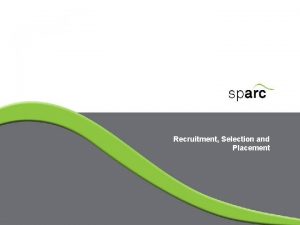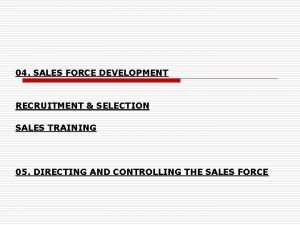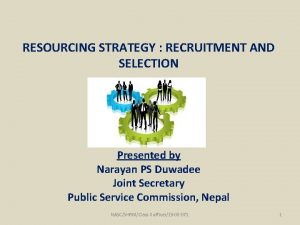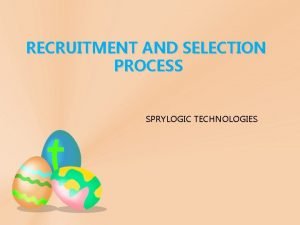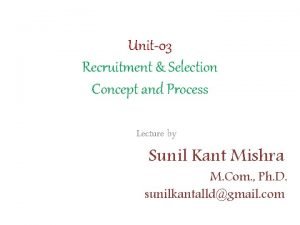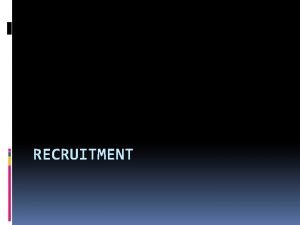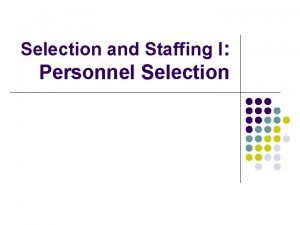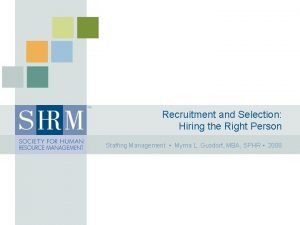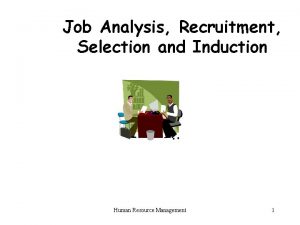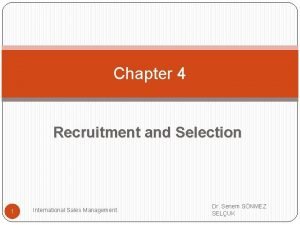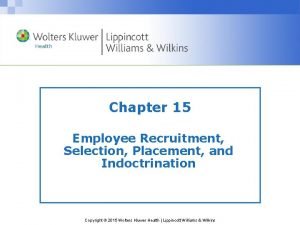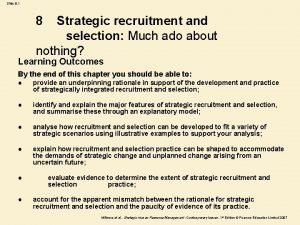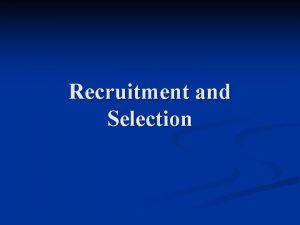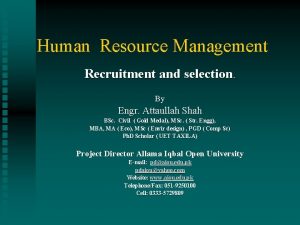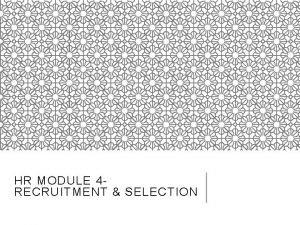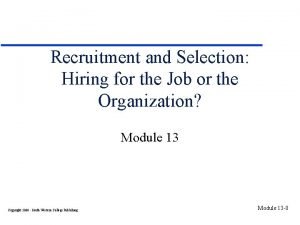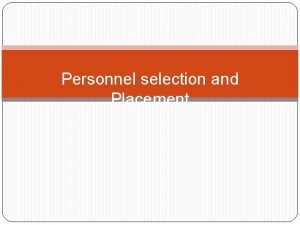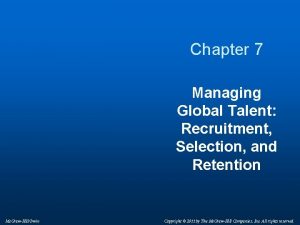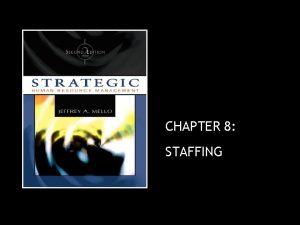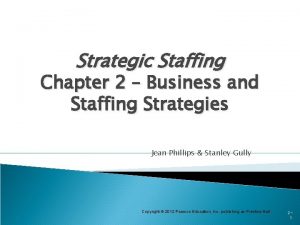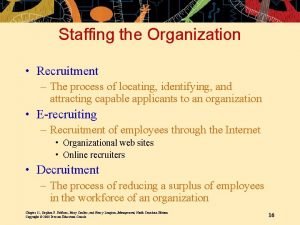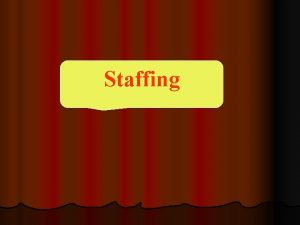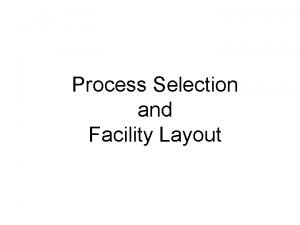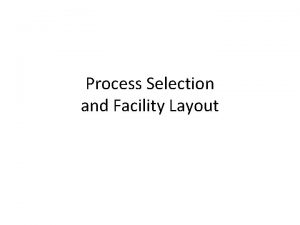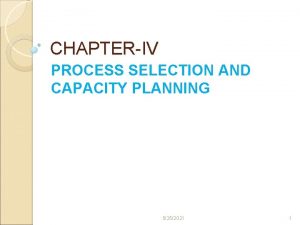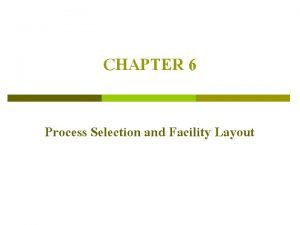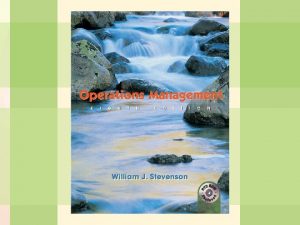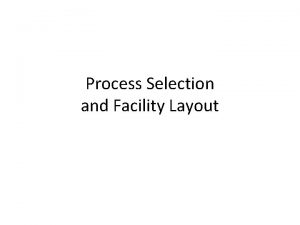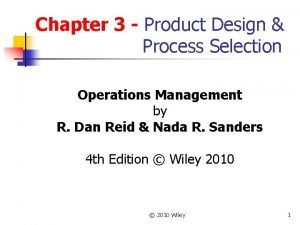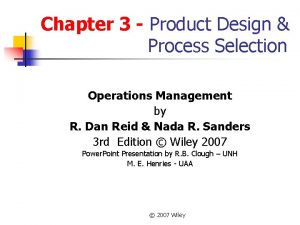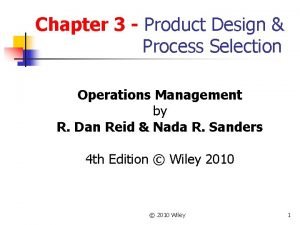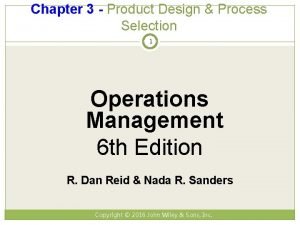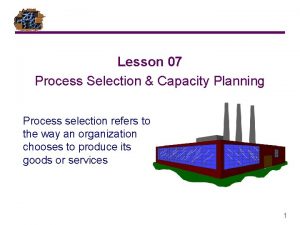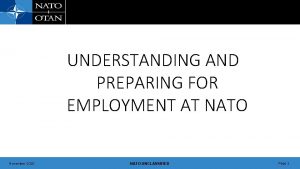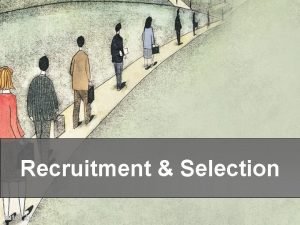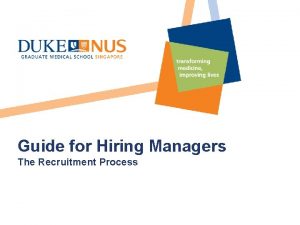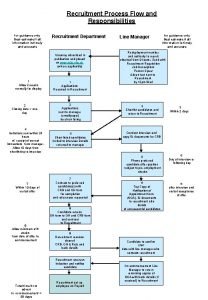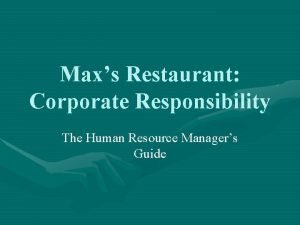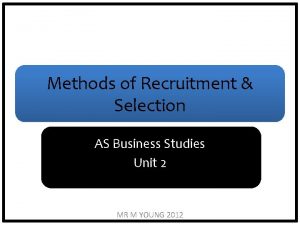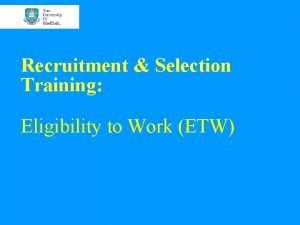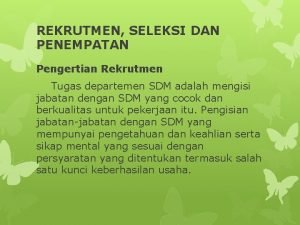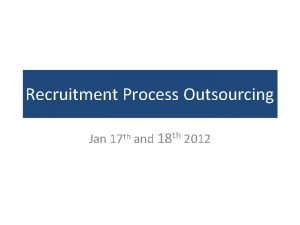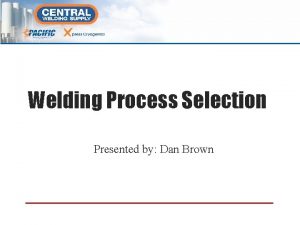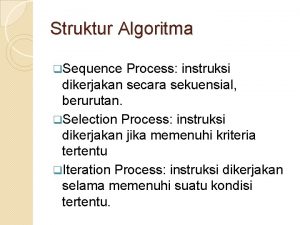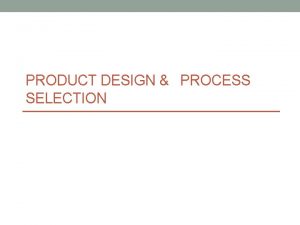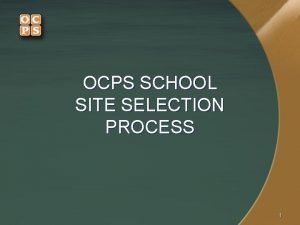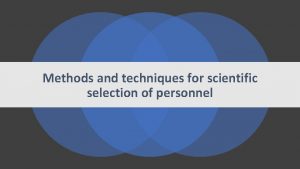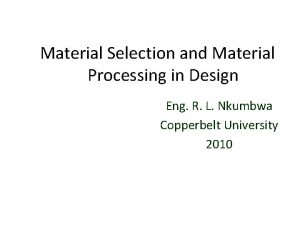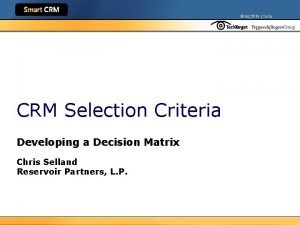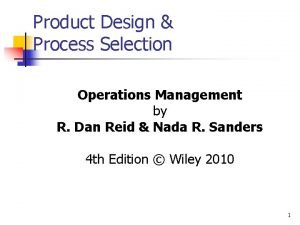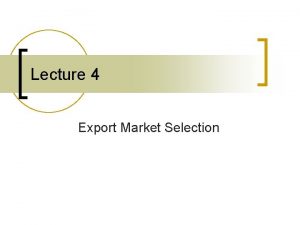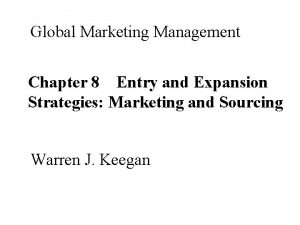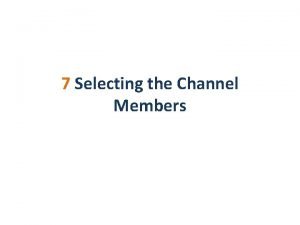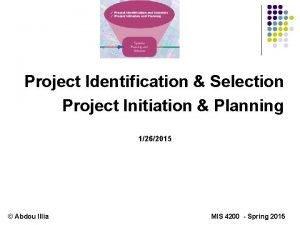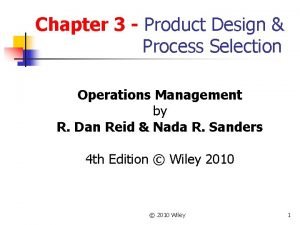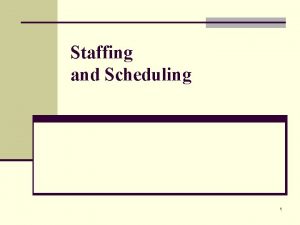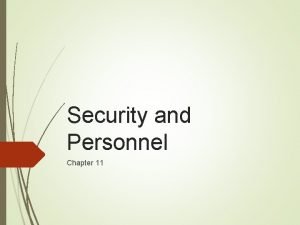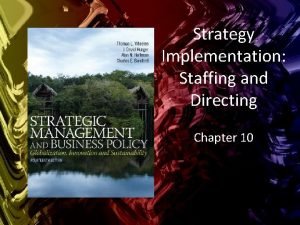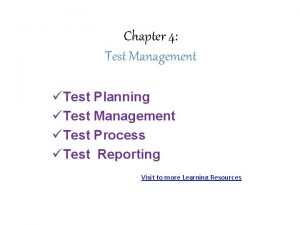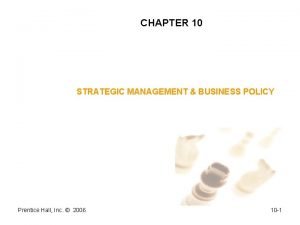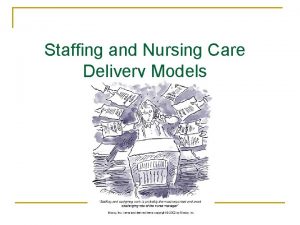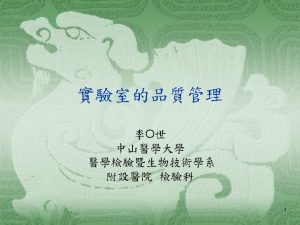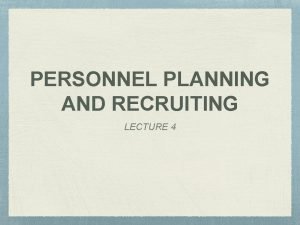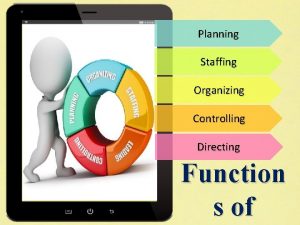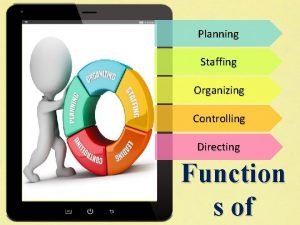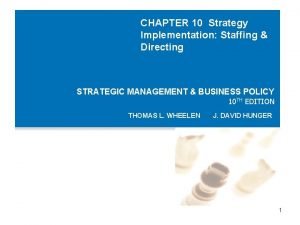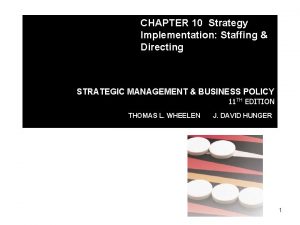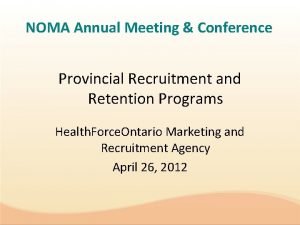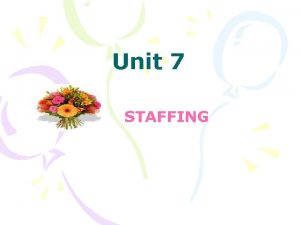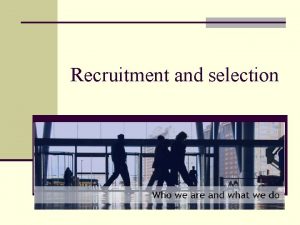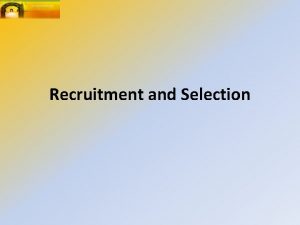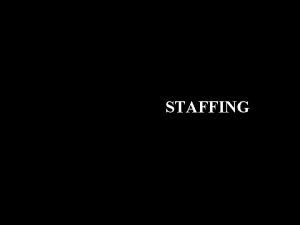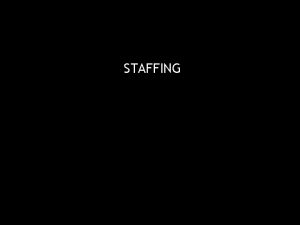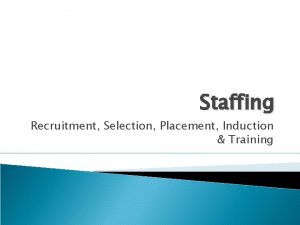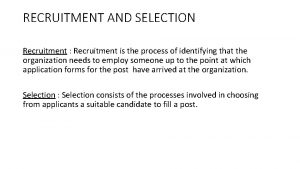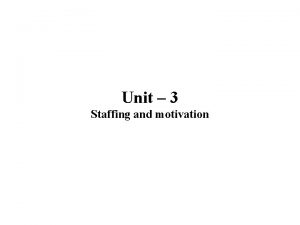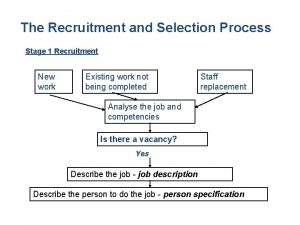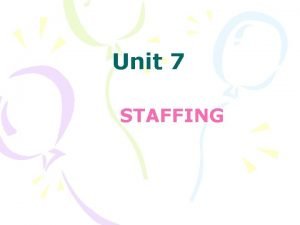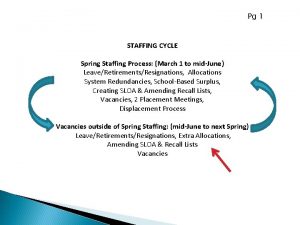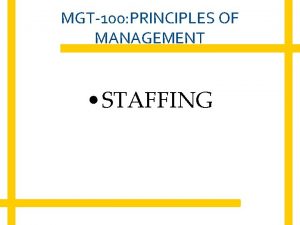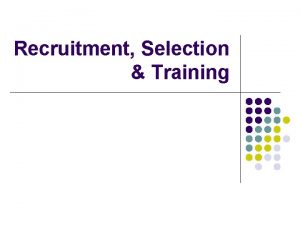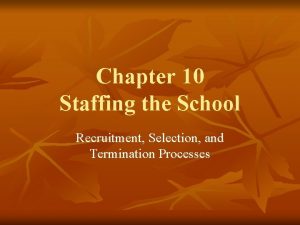STAFFING PROCESS RECRUITMENT AND SELECTION Meaning of Recruitment


































































































- Slides: 98

STAFFING PROCESS: RECRUITMENT AND SELECTION

Meaning of Recruitment According to Edwin Flippo: “Recruitment is the process of searching the candidates for employment and stimulating them to apply for jobs in the organisation “ Recruitment is the activity that links the employers and the job seekers

Other definitions A process of finding and attracting capable applicants for employment process begins when new recruits are sought and end when their applications are submitted. The result is a pool of applicant form which new employees are selected

Other definition cont. . It is a process to discover sources of manpower to meet the requirement of staffing schedule and to employ effective measures of attracting that manpower in adequate numbers to facilitate effective selection of an efficient workforce

Other definitions cont… Recruitment is the first step in filling a vacancy. Includes: Examine the vacancy Considering the source of suitable candidates Making contacts with the candidates Attracting applications from them

Other definitions cont… Recruitment is the function preceding the selection which helps create a pool of prospective employees for the organization so that the management can select the right candidates from this pool ( to expedite the selection process

selection Selection on the other hand is a process whereby out of the many job applicants the best are taken to fill the vacancy. Selection means whittling down the application pool by using the screening tools such as test, assessment centers, background and reference checks.

Difference between recruitment and selection RECRUITMENT SELECTION The recruitment is the process of Selection involves the series of steps searching the candidates for employment by which the candidates are screened and stimulating them to apply for jobs in for choosing the most suitable persons the organisation for vacant posts. The basic purpose is to create a talent The basic purpose of selection is to choose the right candidate pool of candidates to enable the selection of best candidates for the organisation, by attracting more and more employees to apply in the organisation

Recruitment selection A positive process i. e. A negative process as it encouraging more and more involves rejection of the employees to apply unsuitable candidates. Is concerned with tapping the Is concerned with selecting the sources of human resources most suitable candidate through various interviews and tests There is recruitment no contract of Results in a contract of service established in between the employer and the selected employee

Recruitment needs Are of three types Planned – arising form changes in organizational g structure, policy of retirement etc Anticipated – movement in personnel which an organisation can predict by studying trends in internal and external environment Unexpected – resignation, death, accident, illness

Purpose and Importance of effective recruitment The increasing unemployment means that the labour market is large, hence the need to ensure that you attract the right candidates for the jobs High turnover for some occupations are another problem for recruiting Finding the right inducements for attracting and hiring employees can be a problem also

purpose Attract and encourage more and more candidates to apply in the organisation Create a talent pool of candidates to enable the selection of the best candidates for the organisaion Determine present and future requirements of the organisation in conjunction with its personnel planning and job analysis activities as

Minimize unwarranted cost of selection Help increase the success rate of selection process by decreasing the number visibly under qualified or overqualified job applicants Help reduce probability that job applicants once recruited and selected will leave the organization only after a short period of time Meet the organisaion legal and social obligation regarding composition of workforce

Increase organization and individual effectiveness of various recruitment techniques and sources for all types of applicants

Recruitment process Clarifying the hiring philosophy Recruitment planning Developing an effective recruitment strategy Searching for job applicants Screening applicants Gathering information about candidates Making final selection decision

Organizational Objectives HR Planning Employee Clarifying hiring mission and philosophy of the firm Recruitment Planning Evaluation -Type of HR -Numbers of HR Requisitions Developing Recruitment Strategy - Where to recruit -Which Method --When to recruit --What inducement to offer Applicant Search -Develop recruitment method -Activate Evaluation Initial screening Applicants selected Applicants rejected Selection Decision -Multiple hurdle approach -Compensatory approach - Combined approach Gathering information about candidate through selection methods

1. Clarifying hiring philosophy It is important too be clear about hiring mission and philosophy This requires that there should be clarity about what the organization stands for and its future direction This helps the firm to determine the type of people it will require For example a company wish to expand to global market, its hiring requirements will change

2. Recruitment Planning Before beginning to recruit, the firm must state its recruitment objectives. Recruitment objectives are derived from the statement of job vacancies. The objective specify ‘what type’ and ‘how many’ of potential applicants to be contacted to fulfill the HR requirements with qualified applicants The information about the ‘type’ of applicants required is readily obtained from job specification

Recruitment planning (Cont. . ) A firm must recruit more candidates that it actually seeks to hire. However, too large applicant pool has a negative impact on recruitment efficiency. It is difficult to precisely determine the number of candidates to be contacted. However, a firm can make some estimates with the help of yield ration (YR) The YR is the relationship between the number of applicants at one step of the hiring process relative to the number of people who move to the next step.

Recruitment Planning : YR Stage of recruitment process Applicants screened out Yield Ratio Total Applicants 120 0 Initial screening interview 60 2: 1 Selection interview 40 3: 2 Physical examination 30 4: 3 Job offer 15 2: 1 Job offer accepted 10 3: 2 Overall YR 120: 10 12: 1

3. Developing effective recruitment strategy The recruitment strategy involves making decisions about : Where to recruit? Which recruitment method to be used? When to recruit? How to attract people to apply?

Where to recruitment from? In deciding where to recruit, the following general criteria may be applied by firms: Unskilled labor may be recruited locally whereas skilled laborers may be recruited regionally or nationally Local shortage of unskilled labor may require organizations to recruit from larger labor market The location of the organization may influence the decision. A firm in metropolitan city may be able to hire managerial employees from the local labor market

Which recruitment methods to use? The choice of recruitment method is based on the following consideration: Type of job or employee group Cost of method Time taken for results.

When to Recruit? Based on HRP, every organization has a fair idea about when the vacancies are likely to occur due to business expansion, retirements, promotions, resignations etc. (unexpected vacancies in exceptional situations) The decision about when to initiate the process of recruitment depends on the time the hiring process will take.

How to attract people to apply To strengthen and increase the probability of the success of its recruitment efforts, the firm should determine what ‘inducements’ it has to offer to potential candidates. The recruitment effort should be preceded by an assessment of the strengths and weaknesses of the firm that may attract people or repel applicants. The analysis of strengths and weaknesses should include the reputation or image of the firm, location of the office plant, the compensation package, the working conditions, the nature of the job, security of employment etc.

How to attract people to apply (Conti…) The firm can use its strengths as inducements to attract candidates. Flexible work arrangements, promotional opportunities, and performance based rewards are some unique practices. However , in trying to attract candidates, a firm must guard against overselling. When a firm oversells some of its features, it increases the likelihood of unrealistic expectations on the part of candidates.

4. Applicant Search After recruitment plans and strategies have been developed, recruiting can begin. However, strategy cannot be immediately put into practice. First, the HR manager cannot initiate recruiting activities unless there is a pre-requisition from the concerned functional department. Second, most recruitment methods require considerable development work before they can be activated. For example, a firm cannot just visit a business school during placement time to recruit from campus. For campus recruiting, developmental activities begin months ahead of the actual campus visit.

5. Screening of the applicants The applicant pool needs to be scaled down. A firm will select only some candidates, the ‘best’ candidates, from the applicant pool. Initial screening is the part of the staffing process that signifies the last stage of recruitment and the first stage of selection. Based on job description and job specifications, candidates who are obviously unqualified for the position in question are eliminated. Initial screening may be based on information provided by the applicants in the application form

6. Gathering information about candidates The criteria against which applicants are assessed include educational qualifications, work experience, past performance, personal characteristics, physical characteristics etc. A firm must collect as much information as possible about the candidate to make these assessments. The various selection methods enable the firm to collect necessary information needed for the position for which candidates are called for.

7. Final Selection Decision Information about the candidates may be combined in different ways to reach a selection decision. The way a firm will use the information will depend on the particular selection approach of the firm. A firm may follow one of the following three approaches: Multiple hurdle approach Compensatory approach Combined approach

7. Final Selection (Cont. . ) Multiple-hurdle approach Recruitment /Applicant Pool Initial Screening Review of Application Forms Selection Tests Employment Interviews Reference Checks Selection Decision Physical Exam R E J E C T E D Conditional job offer Job Offer

Multiple hurdle approach Any candidate who ‘trips over’ any hurdle goes ‘out of the race’ of job candidacy. For example, if the job requires five years of work experience and the initial screening shows that a candidate has only two years of work experience, the candidate is rejected. Thus there occurs a progression elimination of candidates at each step. However this approach may result in elimination of a potentially good candidate just because he/she received a poor evaluation at a particular step

7. Final selection (continues) Compensatory Approach Under this approach, the lack of certain qualities may be compensated by the presence of certain other qualities. Hence, information about all aspects is gathered for all candidates. This approach is shown with the help of the diagram given in the next slide.

Compensatory approach to selection Recruitment Pool Initial screening Review of application forms Employment interview Selection tests Selection decision and job offer Rejected Assessment centre

7. Final Selection Combined Approach to Selection

Factors affecting recruitment Internal factors Recruitment policy HR planning Size of the firm Cost of recruitment Growth and expansion

Factors affecting recruitment External factors Supply and demand Labour market Image/goodwill Political-social-legal environment Unemployment rates Competitors

Sources of recruitment: internal and external Internal: seeks to fill positions from among the rank of those currently employed Best suitable in succession planning – the process of ensuring a suitable supply of successors for current and future senior or key jobs

Advantages: 1. It is less costly than external recruiting 2. Organisations have a better knowledge of internal applicants skills and abilities than that which can be acquired of candidates in an external recruiting effort

3. Through performance appraisal and other sources of information about current personnel, decision makers typically will have much more extensive knowledge on internal candidates and thus make more valid selection decisions 4. An organisation policy of promotion from within can enhance organizational commitment and job satisfaction, leading to lower employee turnover and productivity 5. Best used for succession planning

Disadvantages: 1. If the organisation has decided to change its business strategy, entrenched managers are problem not the best “change masters”” since the internal recruitment approach simply propagate the old way of doing things 2. Complaints of unit poaching good employees from another unit 3. Politics have a greater impact on internal recruitment. Personal biased decisions towards specific candidates not necessarily based on performance or job requirements

4. Employees who apply for jobs and do not get them may become discontented, : telling unsuccessful applicants why they were rejected and what remedial action might take to be more successful in future is thus crucial 5. Although many times managers post job opening and interviews to all candidates, the manager often knows ahead of time exactly whom he or she wants to hire. Requiring the person to interview a stream of unsuspecting candidates can be a waste of time for all concerned

6. Groups are sometimes not as satisfied when their new boss is appointed form within their own ranks as when he/she is a newcomer. It may be difficult for the insider to shake off the reputation of being “one of the gang” 7. Inbreeding is another potential drawback. When all managers come up through the ranks, they may have a tendency to maintain the status quo, when a new direction is what is required. Balancing the benefit of morale and loyally with the possible inbreeding problem can be a challenge

Sources of internal recruitment Job posting/advertising The most efficient way to do it is to have a job-posting system where announcement for positions is made available to all employees through newsletters, bulletin boards and so on. When properly done, job posting can substantially improve quality of job placement that are made within the organisations Personnel records Another way is to examine personnel records which may reveal employees who are working in job below their education or skill levels, or/and have potential for further training or who already have the right background for the opening

External recruitment Can be important when: A firm cannot get all the employees they need from the current staff When the firm wants to inject a new perspective into running the organisation

EXTERNAL SOURCES External sources Advertising Colleges Agencies Agency Search and Selection Head Hunting Open Evening Referrals and walk –ins Recruitment on the internet

Advertising For this to be successful the firm must address tow issues: The advertising media The advert construction

Advertising media The selection to the media depends on the positions which the firm is recruiting for Local newspapers – for blue collar jobs and jobs whose labour is in plenty supply Specialized jobs will be adverted in trade and professional journals like the economists , etc Jobs with an international focus will be advertised in international dailies or magazines

Constructing an Ad Should have the following four point guide (AIDA): Attention – must attract attention to the Ad or readers may just miss it or ignore it Interest – you can create interest by the nature of the job itself, or with lines such as “will thrive on challenging work”, or use other aspects such as location Desire – by spotlighting the job interest factors with words such as travel or challenge Action - Make sure the ad prompts action with statements such as “call today”

Should contain the following information: Job content ( primary task and responsibilities) A realistic description of the work conditions The location of the job The compensation including fringe benefits Job specification (e. g. education and experience) To whom one should apply

Employment agencies Agencies that charge employees or employers for the placement services Major functions: To increase the pool of possible applicants and to do preliminary screening

Why turn to employment agencies Your firm doesn’t have its own HR department and is not geared to doing recruitment and screening Your firm has found it difficult in the past to generate a pool if qualified applicants You must fill a particular opening quickly You want to reach currently employed individual who might feel more comfortable dealing with agencies than with competing companies You want to cut down on time you are devoting to interviewing

Executive recruiters ( headhunters) Are special employment agencies retained by employers to seek out top management talent for their clients Usually for crucial execute and technical positions Executive recruiters are becoming more and more specialized to recruit for specific functions or industries

advantages The recruiters may have many contacts and are especially experts and skilled at contacting qualified, currently employed candidates who aren't actively looking for a change in jobs They can also keep the firms name confidential until late into the search processes The recruiters save top management's time of advertising and screening

Pitfalls as an employer, you must explain completely what sort of candidate is required and why, Some recruiters are also sales people than professionals – they may be more interested in persuading you to hire a candidate than finding one who will really do the job Recruiters also claim that what their clients say they want is often not accurate, therefore be prepared for some in-depth dissecting of your request.

Guidelines for choosing recruiters Make sure the firm is capable of conducting a thorough search. Make sure they are professional and will not approach the executive talent of a former client for a vacancy with a new client. Meet the individual who will actually handle your assignment. Ensure that the person has the ability to seek out the best candidate and sell them to your firm

Ask how much the search firm charges – 25 – 30% of the guaranteed annual income from the position is appropriate plus some retainer fee Choose a recruiter you can trust with privileged information Talk to some of the firms clients for reference check

College recruiting Sending an employers representative to college campuses to prescreen applicants and create an applicant, pool from that college graduating class is an important source of management trainees, promotable candidates, and professional and technical employees

Problems with on campus recruiting: Its expensive and time consuming – schedules must be set well in advance, company brochures printed, record of interview kept, and much time spent on campus Some recruiters are ineffective and/or show little interest in the candidates and act as superiors

Referrals and walk-ins The firm posts announcements of openings and request for referral's in its bulleting and on its wall boards and intranet. Pros: Current employees can and usually provide accurate information about the job applicants they are referring, especially since their are putting their own reputation at risk The new employee may come with more realistic picture of what working in the firm is like after speaking with friends there Cons: employees bringing their friends who are not necessity qualified

Recruiting on the internet Firms post job description and vacancies on their websites

Developing and using application forms Once you have a pool of applicants, the selection process can begin, and the application form is usually the first step in this process A filled application form provides four types of information: 1. You can make judgment on substantive maters, such as whether the applicant has the education and experience to do the job. 2. you can draw conclusion about the applicants previous progress and growth, a trait that is especially important for management candidates

3. you can draw tentative conclusion regarding the applicants stability on previous work record (here, however, be careful not to assume that an unusual number of job changes necessarily reflects on the applicants stability 4. you may be able to use the data in the application form to predict which candidates will succeed on the job and which will not

Employee selection With a pool of applicants, the next step is to select the best candidate for the job. This means whittling down the application pool by using the screening tools such as test, assessment centers, background and reference checks

Why careful selection is important Selecting the right employee is important for three main reasons: 1. Performance: Your own performance always depends in part on your subordinates. Employees with the right skills and attributes will do a better job for you and the company. Employees without these skills or who are uncompromising or obstructionist wont perform effectively and your won performance and the firm will suffer. The time to screen out undesirables is before they are in the door, not after

2. it is costly to recruit and hire employees in terms of interviewing time, reference checking, traveling etc 3. legal implication of incompetent hiring can be costly and lead to court redress. If you hire a criminal who swindles customers, you will be liable

Basic tests for selection For effective recruiting, therefore, the selection test must be valid and reliable Validity: The test should measure what is supposed to measure. The evidence that is being tested should be job related, in other words, the performance on the test is a valid predictor of subsequent performance on the job

There are two ways to demonstrate test validity: criterion validity and content validity Criterion validity – shows that those who do well in the test also do well on the job and vise versa Content validity – show that the test constitutes a fair sample of the content of the job

reliability Reliability refers to its consistency. It is “the consistency of scores obtained by the same person when retested with the identical test or with an equivalent form of test” If a person score 90% on Monday, then they should score the same on Tuesday for the same test

Types of tests We can classify test according to whether they measure: Cognitive (mental) abilities. Or psychomotor (motor and physical) Personality Interest or achievements

Test for cognitive abilities These includes: Test of general reasoning ability (intelligence) Test of specific mental abilities like memory and reasoning, verbal comprehension, numerical ability ( these are normally referred to as aptitude tests )

Test for motor and physical abilities These includes test such as manual dexterity, reaction time, speed of hands, arms, mechanical ability, weight lifting, body coordination etc Measuring personality and interest These includes persons motivation and interpersonal skills , attitudes, temperaments etc It will measure basic aspects of a applicants personality such as introversion, stability and motivation. These test are done in a projective manner – for example being presented with a picture and asked what you see, picking two statements from one etc

Achievement tests Measure what a person has learned Measure your “job knowledge” in areas like marketing, human resources. E. g. giving people a problem in human resources to solve

Management assessment centre Is a 2 to 3 days simulation in which 10 – 12 candidates perform realistic tasks (like making presentations, meetings, case study analysis – each under watchful eye of experts. Also included are interviews, leadership group discussions, management games,

Other selection techniques Background investigation and reference check Polygraph (lie detector) and honesty testing Graphology Physical examination Substance abuse screening

Background investigation and reference checks Purpose is to verifying job applicants background information and references: These include making telephone enquiries, credit rating, use of reference letters Commonly verified data include legal eligibility for employment, dates of prior employment, education and identification (dates of birth, address to confirm identity)

Reasons to conduct background check Two main reasons to conduct employment background investigation and/or reference check: To verify faction information previously provided by the applicants To uncover damaging information such as criminal records

Physical/medical examination Takes place once the person is hired or sometimes after the person is hired Reasons: To verify that the applicant meets the physical requirements for the Discover any medical limitations you should take into account in placing the applicants To establish a record and baseline of the applicants health for future insurance or compensation claims By identifying health problems, the examination can reduce absenteeism and accidents and, of course determine communicable diseases that may be unknown to the applicant

Interviewing candidates An interview is a procedure designed to obtain information form a person through oral responses to oral enquires. On the basis of these responses the interviewer is able to predict future job performance Interview is by far the most widely used personnel selection method

Types of interviews Selection interview Appraisal interview Exit interview We can classify selection interviews according to: How they are structured Their content – type of questions they contain How the firm administers the interview

How they are structured Interviews can be : Structured or unstructured Unstructured or nondirective There is generally no set format to follow so the interview can take various direction Lack of structures allow the interviewer to ask follow up questions and pursue points of interest as they develop

Structured or directive interviews The questions and acceptable responses are specified in advance and the responses rated for appropriateness of content All interviewers generally ask all applicants the same questions, and hence: Tend to be more reliable and valid It increases consistency across candidates Enhances job relatedness Reduces overall subjectivity ( and thus the potential for bias) May enhance ability to withstand legal challenges On the other hand structured interviews do not provide opportunity to pursue points of interest as they develop

Interview content – type of questions These could be situational interview questions asking candidates how they would behavior in a given hypothetical situation and evaluating the applicant based on the choice made Behavior interview questions asks interviewees to describe how they would reacted to an actual situation in the pasts

Job related interviews – the interviewer tries to deduce what the applicant on the job performance will be base on his or her answers to questions about past behavior. The question here do not revolve around hypothetical questions but ask job related questions e. g. what does human resources recruitment and selection involve

Stress interview – seeks to make the applicant uncomfortable with occasionally rude questions Aims is supposedly to spot sensitive applicants and those with low or high level of stress tolerance Stress interviews may help unearth hypertensive applicants who might overreact to mild criticism with anger and abuse

Puzzle questions - meant to see how a candidates reacts under pressure. Used mainly for technical and finance related areas

Administering the interview Interviews can be administered in several ways: One on one A panel interview Sequentially or all at once Computerized or personally

Administering interviews (cont. . Personal interviews (one on one) - two people meet alone and one interviews the other by seeking oral responses to oral inquires Sequential – several persons interview the applicant in sequence, before a decision is made. This can be structured or unstructured Panel – a group of interviewers question the candidate. This may have advantage over the others because in sequential candidates may cover the same ground over again with each interviewer. But panel format lets the interviewers ask follow up questions based on the candidates answer. This may elicit more responses

Computerized interview - in this case a job candidate’s oral and/visual responses are obtained in response to computerized oral or visual or written questions and/situation A candidate is presented with a series of specific questions regarding his/her background, , experience, education, skills, knowledge and work attitudes that relate to the job for which the person has applied The questions are presented in a multiple choice and questions come in rapid sequence After the computerized interview there is usually a one on one

What can undermine an interviews usefulness –pitfalls/errors First impression – which one gets from the interviewees application form and personal appearance Misunderstanding of the job - interviewers who do not know precisely what the job entails and what sort of candidate is best suited for it usually make their decisions based on incorrect stereotype of what a good applicant is

Candidates-order (contrast) error and pressure to hire - The order in which you see applicants affect how you rate them. After first evaluating unfavorable candidates, an average candidate can score quite highly Pressure to hire accentuate problems like the error or contrast

Non verbal behavior and impressions management - - eye contact, energy levels , low voice etc can influence the interviewers decision Body language, smile, posture may interfere with the interviewers judgment Effect on personal characteristics stereotyping : Involves categorizing groups according to general traits then attributing those traits to a particular individual once the group membership is known attractiveness, gender, race - in general, individuals ascribe more favorable traits and more successful life outcomes to attractive people Some see men or women as more suitable or a certain race as more suitable

Interviewer’s behavior - some interviewers talk so much that the applicant have no time to answer questions. On the other extreme, some interviewers let the applicant dominate the interview and so don’t ask questions. Neither is good situation Others play the role of a judge or psychologist

Designing and conducting an effective interview – steps 1. The structured situational interview –procedure: 1. Job analysis -write a job description and list of duties, knowledge, skills and abilities 2. Rate the job duties 3. Create the interview questions –situational questions, job knowledge questions etc 4. Create benchmark answers with a five point rating scale 5. Appoint an interview panel and conduct interview – 3 – 6 members preferably the same employees who wrote the questions , also include job supervisor and/or incumbent, and an HR representative

Conducting an interview steps The questions: Structure your interview questions so that it is standardized, consistent and relevant. This will include ensuring that : You base your questions on action job Use knowledge, situational and behavior oriented questions and an objective criteria to assess the interviewees response Train your interviewers Use the same questions for all candidates Use rating scales to rate answers Use multiple interviewers for panel interviews to reduce bias Control the interview – limit the interviews follow up

2. Prepare for the interview The interview should take place in a private room with minimum interruptions Prior to the interview, review the candidates application and resume and not areas that are vague or that may indicate strengths or weaknesses Remember the duties of the job and the specific skills and traits that you are looking for – review the job specifications Start the interview with an accurate picture of the traits for the ideal candidate.

3. Establish rapport – put the person at ease – greet the applicant, drop in some courtesy words and start interview with non related question, e. g. . About the whether Be aware of peoples background and make additional efforts to make such people relax

4. Ask questions – follow your list of questions. Don’t ask questions which can be answered with yes or no, don’t push words into the applicants mount, don’t interrogate the applicant as if the person is a criminal , don’t be patronizing, sarcastic – ask open ended questions, listen to the candidate, , encourage them 5. Close the interview – leave time to answer any questions the candidates may have End the interview with a positive not, tell the applicant the next steps, make any rejections diplomatically 6. Review the interview – review notes and fill in the structured interview guide
 Selection process in staffing
Selection process in staffing Recruitment and selection course outline
Recruitment and selection course outline Acmee model of sales training
Acmee model of sales training Recruitment and induction process
Recruitment and induction process Components of employee resourcing strategy
Components of employee resourcing strategy Recruitment and selection definition
Recruitment and selection definition Meaning of recruitments
Meaning of recruitments Talent aquisition meaning
Talent aquisition meaning Recruitment needs are of three types
Recruitment needs are of three types Objectives of staffing
Objectives of staffing Recruitment and selection: hiring the right person
Recruitment and selection: hiring the right person Sources of recruitment and selection
Sources of recruitment and selection Job analysis recruitment and selection
Job analysis recruitment and selection Human resources management exam questions and answers pdf
Human resources management exam questions and answers pdf Recruitment and selection of sales personnel
Recruitment and selection of sales personnel Recruitment selection and placement
Recruitment selection and placement Strategic recruitment and selection
Strategic recruitment and selection Recruitment and selection definition
Recruitment and selection definition New trends in recruitment and selection
New trends in recruitment and selection Selection in human resource management
Selection in human resource management Recruitment and selection definition
Recruitment and selection definition Recruiting yield pyramid
Recruiting yield pyramid Difference between hiring and recruitment
Difference between hiring and recruitment Recruitment selection and placement
Recruitment selection and placement Two way selection and multiway selection in c
Two way selection and multiway selection in c Two way selection and multiway selection in c
Two way selection and multiway selection in c Mass selection and pure line selection
Mass selection and pure line selection Global recruitment selection
Global recruitment selection Balancing selection vs stabilizing selection
Balancing selection vs stabilizing selection Artificial selection vs natural selection
Artificial selection vs natural selection K selected
K selected Natural selection vs artificial selection
Natural selection vs artificial selection Difference between continuous and discontinuous variation
Difference between continuous and discontinuous variation What is stablizing selection
What is stablizing selection What is exponential growth in ecology
What is exponential growth in ecology Natural selection vs artificial selection
Natural selection vs artificial selection Components of strategic staffing
Components of strategic staffing 8 staffing process
8 staffing process What is strategic staffing
What is strategic staffing Recruitment is the process of locating identifying and
Recruitment is the process of locating identifying and Factors affecting staffing pattern in nursing
Factors affecting staffing pattern in nursing Importance of process selection and facility layout
Importance of process selection and facility layout Process matrix
Process matrix Process selection and capacity planning
Process selection and capacity planning Chapter 6 process selection and facility layout
Chapter 6 process selection and facility layout Layout
Layout Process selection and facility layout
Process selection and facility layout Process selection and facility layout
Process selection and facility layout Process selection types
Process selection types Product design and process selection
Product design and process selection Product design in operations management
Product design in operations management Process selection in operations management
Process selection in operations management Process selection and capacity planning
Process selection and capacity planning Identifying and selecting systems development projects
Identifying and selecting systems development projects Product and process design in operations management
Product and process design in operations management Dinesh jadhav hiren international
Dinesh jadhav hiren international Nato talent acquisition platform
Nato talent acquisition platform 4 stages of recruitment process gcse
4 stages of recruitment process gcse Flowchart examples
Flowchart examples Recruitment process flow
Recruitment process flow Human resource management in restaurants
Human resource management in restaurants Recruitment process business studies
Recruitment process business studies Hp confidential
Hp confidential Cavinkare recruitment process
Cavinkare recruitment process Etw meaning recruitment
Etw meaning recruitment Seleksi dan penempatan karyawan
Seleksi dan penempatan karyawan Outsourcing definition tutor2u
Outsourcing definition tutor2u Selection of welding process
Selection of welding process Jika instruksi dikerjakan jika memenuhi kriteria tertentu
Jika instruksi dikerjakan jika memenuhi kriteria tertentu Selection objectives
Selection objectives Product selection process
Product selection process Ocps pupil assignment
Ocps pupil assignment Scientific selection procedure
Scientific selection procedure Process selection charts
Process selection charts Crm selection criteria
Crm selection criteria Process selection operations management
Process selection operations management Market selection
Market selection Chapter 8 the international market selection process
Chapter 8 the international market selection process Channel member selection
Channel member selection Project portfolio management process steps
Project portfolio management process steps Project identification and selection
Project identification and selection Process selection in operations management
Process selection in operations management Planning and staffing
Planning and staffing Staffing and scheduling in nursing management
Staffing and scheduling in nursing management Positioning and staffing the security function
Positioning and staffing the security function Staffing issues in strategy implementation
Staffing issues in strategy implementation Defect rejection ratio formula
Defect rejection ratio formula Staffing and directing.
Staffing and directing. Modular nursing method
Modular nursing method Primary nursing care
Primary nursing care Planning organizing leading and controlling
Planning organizing leading and controlling Personnel planning is
Personnel planning is Staffing and controlling
Staffing and controlling Planning organizing staffing directing controlling
Planning organizing staffing directing controlling Safe staffing ratios: benefiting nurses and patients
Safe staffing ratios: benefiting nurses and patients Staffing and directing
Staffing and directing Staffing and directing
Staffing and directing Comparative benefit model
Comparative benefit model Edcdp
Edcdp
